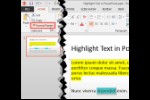A Glow effect adds a hazed color perimeter outside the shape area, and by default, the Glow colors emanate from the active Theme. These default Glow colors work most of the time but of course, you can change the Glow color to something entirely different. In this tutorial, you'll learn how you can change this Glow color to any color you want, as shown within the sample Glow effects you see in Figure 1, below.

Figure 1: Change the Glow effect color
Follow these steps to change the Glow effect color in PowerPoint 2013 for Windows:
- Select the shape so that the Ribbon area shows the Drawing Tools Format tab, as shown highlighted in red within Figure 2. Activate this Ribbon tab by clicking on it. Within the Drawing Tools Format tab, click the Shape Effects button (highlighted in blue within Figure 2).

Figure 2: Shape Effects button within Drawing Tools Format tab of the Ribbon Note: The
Drawing Tools Format tab is a
contextual tab. These tabs are special tabs in the
Ribbon that are not visible all the time. They only make an appearance when you are working with a particular slide object which can be edited using special options.
- This brings up the Shape Effects drop-down gallery as you can see in Figure 3. Within the Shape Effects drop-down gallery, choose Glow and then choose More Glow Colors from the sub-gallery, as shown highlighted in red within Figure 3.

Figure 3: More Glow Colors option within Glow sub-gallery - This brings up the Colors flyout menu (refer to Figure 3). Here you can choose any color for the glow using the following options:
Theme Colors
- Here you can select any of the colors which are from the active Theme of the presentation. You can also select any of the 5 tints or shades for any Theme color. Learn more about Themes here.
Standard Colors
- Here you can choose from any of the ten standard colors. These ten standard colors are just choices of colors that PowerPoint believes to be widely used. You don't have to limit yourself to either the Theme colors or Standard colors, as we will explore next. It's a good design idea to use Theme colors as far as possible.
Recent Colors
- Here you can find the colors most recently used. If you have just launched PowerPoint and created a new presentation, then the Recent Colors option may be entirely absent since you haven't selected any color recently!
More Fill Colors
- This option is to summon the Colors dialog box as shown in Figure 4. This dialog box has two tabs: Standard and Custom. First, select the Standard tab (again, refer to Figure 4).

Figure 4: Standard tab within the Colors dialog box - The Standard tab offers 127 colors in a honeycomb style palette, in addition to 14 gray shades, black and white. You can even change the transparency value of the selected color in the Transparency slider below. If you want more color choices, then select the Custom tab of the same dialog box, as shown in Figure 5.

Figure 5: Custom tab within the Colors dialog box - Within the Custom tab, you can chose any color from the spectrum and later adjust the selected color's luminosity with the slider on the right. You can even enter specific values of RGB and HSL to create a specific color. All these combinations provide 16 million color choices!
- Again, you can even change the transparency value of the selected color in the Transparency slider below.
- Choose any color and click OK to apply it.
- In Figure 6, you can see that the glow color of our previously selected Rectangle shape (see Figure 2) has been changed from orange to pink.

Figure 6: Rectangle shape with changed glow color - Remember to save your presentation often.









